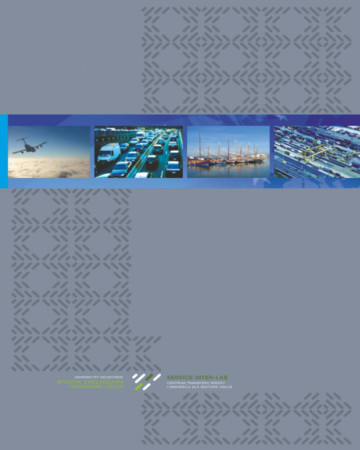
ISSN: 1644-275X
eISSN: 2353-3005
OAI
DOI: 10.18276/ptl.2017.39-07


Lista wydań /
nr 3 (39) 2017
PRZESŁANKI I UWARUNKOWANIA ROZWOJU EKOSYSTEMÓW MOBILNOŚCI W OPARCIU O INTELIGENTNE SYSTEMY TRANSPORTOWE
| Autorzy: |
Elżbieta
Załoga
Wydział Zarządzania i Ekonomiki Usług, Uniwersytet Szczeciński Władysław Wojan Wydział Zarządzania i Ekonomiki Usług, Uniwersytet Szczeciński |
| Słowa kluczowe: | polityka transportowa UE ekosystemy mobilności |
| Data publikacji całości: | 2017 |
| Liczba stron: | 14 (71-84) |
| Klasyfikacja JEL: | L91 L98 |
Abstrakt
The development of mobility ecosystems is a consequence of the development of intelligent transport sys-
tems (ITS), which are one of the tools used to achieve the long-term goals of the EU’s common transport
policy. The development of technologies related to mobile devices and universal access to the Internet cre-
ates a basis for offering new services in the transport sector. Their development and dissemination requires
system integration on three levels: institutional, technological and operational. Example of activities in this
direction is the EU initiative C-ITS Platform and mobility ecosystems operating on the basis of Mobility as
a service (MaaS) services. The rationale and effects of these innovative solutions are the main focus of this
article.
Pobierz plik
Plik artykułu
Bibliografia
| 1. | Biała księga. Plan utworzenia jednolitego europejskiego obszaru transportu – dążenie do osiągnięcia konkurencyjnego i zasobooszczędnego systemu transportu. Rada Unii Europejskiej, Bruksela 29 marca 2011, COM(2011) 144. |
| 2. | Chan Kim, W., Mauborgne, R. (2005). Blue Ocean Strategy. Harvard Business School Press. |
| 3. | Cooperative Intelligent Transport Systems (2016), Brussels: EU. Pobrane z: www. transport-research.info, s. 2 (20.02.2017). |
| 4. | Corwin, S., Vitale, J., Kelly, E., Cathles, E. (2015). The future of mobility How transportation technology and social trends are creating a new business ecosystem. Pobrane z: www2.deloitte.com/content/dam/Deloitte/br/Documents/manufacturing/Future_of_mobility.pdf (12.09.2017). |
| 5. | Cyfryzacja europejskiego przemysłu. Pełne wykorzystanie możliwości jednolitego rynku cyfrowego, SWD(2016) 110 final (2016). Bruksela. |
| 6. | European Strategy on Cooperative Intelligent Transport Systems (C-ITS), COM (2016) 766. |
| 7. | Europejska strategia na rzecz mobilności niskoemisyjnej, SWD(2016)244 final (2016) Bruksela: KE. |
| 8. | Hoffmann, R.M. (2003). Możliwości rozwoju wirtualnych przedsiębiorstw. Realizacja i rozwiązania praktyczne w systemie wspomagania organizacji. Katowice: Akademia Ekonomiczna w Katowicach. |
| 9. | http://europa.eu/rapid/press-release_MEMO-13-897_pl.htm (16.01.2017). |
| 10. | https://www.theguardian.com/business/2017/jan/09/fewer-car-owners-more-driverless-[]vehicles-future-survey-reveals (15.01.2017). |
| 11. | Iansiti, M., Levien, R. (2004). The keystone advantage: what the new dynamics of business ecosystems mean for strategy, innovation, and sustainability. Cambridge: Harvard Business Press. |
| 12. | Kahneman, D. (2003). Maps of bounded rationality: Psychology for behavioral economics. American Economic Review, 93(5), 1,449–1,475. |
| 13. | Komunikat Komisji do Parlamentu Europejskiego, Rady, Europejskiego Komitetu Ekonomiczno-Społecznego i Komitetu Regionów. Europejska strategia na rzecz współpracujących inteligentnych systemów transportowych – ważny krok w kierunku mobilności pojazdów współpracujących, połączonych i zautomatyzowanych, COM(2016)766 final, (30.11.2016). Bruksela: KE. |
| 14. | Mobility as a service. Exploring the opportunity for mobility as a service in the UK. CEO Transport Systems Catapult, July 2016, dostęp 12.01.2017. |
| 15. | Mullainathan, S., Thaler, R.H. (2000). Behavioral economics, no. w7948. National Bureau of Economic Research. |
| 16. | Murphy, T., Cotteleer, M.J. (2015). Behavioral strategy to combat choice overload. Deloitte University Press, December 10. Pobrane z: http://dupress.com/articles/behavioralstrategy-choice-overload-framework/?coll=11936 (14.08.2017). |
| 17. | Pankratz D. M., Willigmann P., Kovar S., Sanders J. (2017). Framing the future of mobility. Deloitte Review, 20, 1–20. |
| 18. | Rea, B., Stachura, S., Wallace, L., Pankratz, D.M. (2016). Navigating the future of work. Deloitte Review, 21, 185. |
| 19. | Rozporządzenie Parlamentu Europejskiego i Rady (UE) 2016/679 z dnia 27 kwietnia 2016 w sprawie ochrony osób fizycznych w związku z przetwarzaniem danych osobowych i w sprawie swobodnego przepływu takich danych oraz uchylenia dyrektywy 95/46/WE. Pobrane z: https://eur-lex.europa.eu/legal-content/PL/TXT/?uri=CELEX%3A32016R0679 (17.08.2017). |
| 20. | Sprawozdanie Komisji dla Parlamentu Europejskiego i Rady. Wdrażanie dyrektywy Parlamentu Europejskiego i Rady 2010/40/UE z dnia 7 lipca 2010 r. w sprawie ram wdrażania inteligentnych systemów transportowych w obszarze transportu drogowego oraz interfejsów z innymi rodzajami transportu, Bruksela 2014, COM (2014)624 final, s. 5. Pobrano z: www.europa.eu (15.01.2017). |
| 21. | van Voorsttot Voorst, M.P. (2011). Future of the super inteligent transport systems. EFP Brief, 202, s. 1–4. Pobrane z: www.foresight-platform.eu/wp-content/upload/2011/11/EFP-Brief-No.-202_Future-of-Superintelligent-Transport-Systems.pdf (15.01.2017). |
| 22. | White Paper. Common Transport Policy till 2010 – time to decide. (2001). Brussels. Commission of the European Communities. |
| 23. | Wniosek. Decyzja Parlamentu Europejskiego i Rady zmieniająca dyrektywę 2010/40/UE w odniesieniu do okresu przyjmowania aktów delegowanych, COM(2017)136 final (20.09.2017). |
| 24. | Załoga, E. (2013). Trendy w transporcie lądowym Unii Europejskiej. Szczecin: Uniwersytet Szczeciński. |
| 25. | Załoga, E., Wojan, W. (2017). Political and market challenges towards services using Intelligent Transport Systems. Smart Solutions in Today’s Transport. Wiesbaden: Springer International Publishing. |